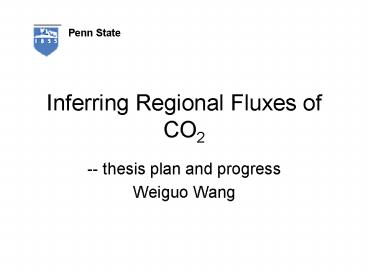Inferring Regional Fluxes of CO2 - PowerPoint PPT Presentation
Title:
Inferring Regional Fluxes of CO2
Description:
entrainment. subsidence. dh/dt, growth. W. CBL. Cm. e.g. ~30km. Components in the budget equation ... From a simple model, entrainment fluxes, ... – PowerPoint PPT presentation
Number of Views:23
Avg rating:3.0/5.0
Title: Inferring Regional Fluxes of CO2
1
Inferring Regional Fluxes of CO2
Penn State
- -- thesis plan and progress
- Weiguo Wang
2
Outline
- Research background
- Methods proposed
- 1 Flux footprint
- 2 Objective analyses/assimilation
- 3 Atmospheric Boundary Layer Budget
- ? Comparison
3
Proposed work
Current Status of NEE measurements
Inverse study
Forest inventory
decade
Tower flux
year
GAP
Time Scale
month
Chamber flux
day
Airborne flux
hour
(1m)2 (1km)2 (10km)2 (102km)2 (103km)2
R(earth) Spatial Scale
4
Method 1. footprint function
- Use a footprint function to decompose measured
fluxes for different vegetation - - Willow Creek upland
- - Lost Creek wetland
- - WLEF mixed
- Estimate the flux in a region based on vegetation
maps.
5
Source area and weight
Example
wind
?Lost Creek
40km
? WLEF
? Willow Creek
6
Method 2. Objective Analysis/Assimilation
- In preparation
- Estimated fluxes or parameters constrained by
- - observations, e.g., tower fluxes, mixing
ratios - - physical and biosphere models
7
Method 3. ABL Budget
- Equation
- Estimate ltcgtm-ltcgtPBL
- Estimate advection using CO2H2O correlation
- --- evidence of CO2H2O correlation
8
Components in the budget equation
subsidence
C Above ABL
W
entrainment
dh/dt, growth
h, 1km
advection
advection
Cm
CBL
surface
Surface flux,F0
e.g. 30km
9
Equation
H, CBL height, wc,
meso-scale flux at H, usually small
ltcgt, mixing ratio just above the CBL
10
Some terms not easy to construct in reality
11
1 ltcgtm-ltcgt
- It is somewhat difficult to estimate the
difference. - No long-term measurements of ltcgt
- Measurements at other sites? E.g., CAR
- Marine BL at the same latitude? 2-3 ppm
difference - Nighttime 396-m values?
- Inferred from water vapor? (considering the same
mixing process
12
- From a simple model, entrainment fluxes,
? Will be tested by data, although not much data
available
13
2 advection term
- Difficult to estimate, because
- sparse measurements of CO2
- calibration problems (an example)
14
CO2 mixing ratio comparison between Willow Creek
and WLEF
2000
1999
DAY OF YEAR
2001
WLEF CO2 - Willow CO2 in Winter
Offset is apparent
15
Use CO2-H2O correlation
- Under fair weather/clear sky condition, water
vapor is transported into atmosphere mostly by
plant evapotranspiration over vegetated areas - Surface vegetation is a major sink/source for
CO2/H2O - CO2 is negatively correlated with water vapor due
to photosynthesis process. - Absolute values of CO2 and q mixing ratio are
affected by, e.g., large-scale weather. ?c and ?
q can eliminate them to some degree. So ?c? q
are correlated better than cq.
16
IHOP_2002 data(International H2O Project_2002)
17
cq
?c ?q
r-0.90 r-0.89 r-0.92 r-0.95
r0.01 r-0.45 r-0.86 r-0.92
18
- Spectral analyses indicated that the correlation
is time- and (spatial) scale- dependent - The negative correlation appear earlier on
smaller scales than on larger scales.
19
However, Correlation is not always high
- (1) NDVI
- (2) Precipitation
- (3) Time
- (4) Wind speed
20
(1) Correlation NDVI
- Larger NDVI, higher correlation
- Scattered distribution indicates other factors
Cq
?c ?q
21
(2) Correlation precipitation
- Correlation depends on weather history (e.g.,
rain) - If more water vapor evaporated from soil (e.g.,
after rain), the negative correlation is
weakened. - Correlation is more sensitive to weather for low
NDVI than high NDVI
22
Correlation Precipitation
23
(3) correlation time
Cq ?c ?q
24
(4) correlation wind
cq ?c ?q
25
Relationship between ?c/?x ?q/?x
26
k WUEk is well correlated with WUE
27
(No Transcript)
28
CO2H2O Summary
- Good correlation between k and WUE is very
useful in practice. - Use water vapor gradient to estimate CO2
gradient in some cases. - To use the results, need more experiments or
data, e.g., Under what conditions, CO2water is
high































